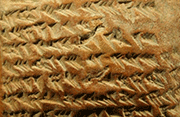E-Archive
Off the Beaten Track
in Vol. 18 - January Issue - Year 2017
The Wanderers

Ancient clay inscriptions used to track the planet Jupiter

Babylonian Astronomers
The two men worked silently at the top of the tower. Their long, thick beards, heavy woolen coats and tall, cylindrical hats offered protection against the cold winter night. The vault of the sky twinkled with innumerable stars, so bright and so close that it seemed possible to touch them by simply stretching out a hand. One of the men stared intently at the sky with an instrument that appeared similar to a mariner’s sextant. Occasionally he called out a number and the other man immediately traced a mark in the wet clay slab on the table in front of him. They toiled into the night, breathing a sigh of relief when the first light of dawn appeared to the east…
****
The ancients had noticed that certain stars would pass through the sky in regular and predictable patterns, while other stars appeared immobile. The ancient Greeks called these moving stars planētēs, which means "wanderer".
By the second millennium BC, Babylonian astronomers had identified seven planets, including the Sun and the Moon, all of which were believed to orbit around the Earth. Surprisingly, it would take another 3,800 years before the remaining planets in our solar system were discovered!
In the fifth century BC, the Greek philosopher Anaxagoras first suggested that the Sun was a star and not a planet, but his ideas were ignored. Two centuries later, another Greek philosopher named Aristarchus of Samos stated that the Earth was a planet revolving around the Sun together with the other planets, but his theory was also discounted. It wasn’t until the sixteenth century that the heliocentric model proposed by the Polish astronomer Nicolaus Copernicus gained acceptance. The Sun was placed at the center of our planetary system and the planets were placed in their correct order, with the Moon orbiting around the Earth.
With their eastward expansion, the Greeks acquired much of the astronomical knowledge that had been accumulated over the millennia by the Akkadians, Sumerians, Babylonians and Assyrians. It’s interesting to examine how the names of planets given by these ancient civilizations were subsequently adopted in the West through the Greek and Latin languages.
Shamash, the Sun god, meted out justice. He became known as Helios in Greek and as Sol in Latin. With the invention of the week as a unit of measurement of time, the name of this deity was assigned to the first day of the week, from which we have Sunday in English.
The Moon was named after Sîn, often depicted as a self-generating plant, a reference to the belief that the moon regenerates itself after each waning. This god was known as Selene in Greek and as Luna in Latin. The second day of the week, Monday in English and lunes in Spanish, bears his name.
Mars was named Nergal by the Babylonians, in honor of the greatest god of the Underworld. This planet was known for its distinctive red color and became associated with Mars, the Roman god of war (and therefore blood). The third day of the week was named in his honor: martedì in Italian and Tuesday in English, after the Germanic god of war Tīw.
The Akkadians called Mercury by the name of Sahitu, meaning "jumpy" or "darting", reflecting the fact that it moves very quickly across the sky. In fact, a year on Mercury lasts only 88 days. The Greeks and the Romans named this planet after the winged messenger of the gods: Hermes and Mercurius. The fourth day of the week bears his name, with Wednesday in English coming from Woden, the Scandinavian god of victory.
Marduk was the protector of the Babylonian king and a fitting name for Jupiter, by far the largest planet in the solar system. The Greeks knew him as Zeus and the Romans as Iuppiter. The fifth day of the week bears his name: jueves in Spanish and Thursday in English, from the Scandinavian god Thor.
For the Babylonians, Ishtar was the sister of the Sun and the only female among the planets. Being the brightest planet, Venus was associated with beauty. Aphrodite for the Greeks and Venus for the Romans, her name is reflected in the sixth day of the week: viernes in Spanish and Friday in English, from Freya, the Scandinavian goddess of love.
Saturn was named Ninurta by the Sumerians. Known as Cronus by the Greeks and as Saturnus by the Romans, all three of these civilizations worshipped this deity as their god of agriculture. Saturn gave his name to the seventh day of the week.
By Giovanni Gregorat, Contributing Editor MFN
Author: Giovanni Gregorat




























